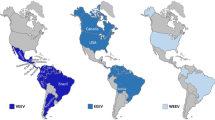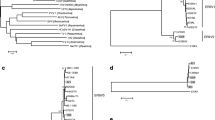Abstract
Eastern equine encephalitis is a viral zoonosis that exhibits complex distribution and epidemiology, and greater importance should be given to this disease by the public-health authorities. In Brazil, although eastern equine encephalitis virus (EEEV) has been identified in vectors and antibodies are sometimes detected in horses and humans, there have been no records of equine encephalitis in horses caused by this virus during the last 24 years. This study describes eighteen cases of eastern equine encephalomyelitis that occurred in six Brazilian states between 2005 and 2009. Viral RNA was identified using semi-nested RT-PCR to detect members of the genus Alphavirus, and by genetic sequencing. The gene encoding NSP1 was partially amplified, and after genetic sequencing, eighteen sequences were generated. All eighteen strains were classified as belonging to lineage III of American EEEV. These findings could be an indication of the importance of this virus in animal and human public health.


Similar content being viewed by others
References
Schleinger S, Schleinger MJ (2001) Togaviridae: the viruses and their replication. In: Knipe DM, Howley PM (eds) Fundamental virology. Lippincott, Philadelphia, pp 567–588
Acha PN, Szyfres B (2003) Fiebre Del Nilo Occidental. In: Acha PN, Szyfres B (eds) Zoonoses y enfermedades transmisibles comunes al hombre y a los animales, vol 2. Organización Panamericana de la Salud, Washington, pp 278–283
Figueiredo LTM (2007) Emergent arboviruses in Brazil. Rev Soc Bras Med Trop 40:224–229. doi:10.1590/S0037-86822007000200016
Vasconcelos PFC, Travassos da Rosa JFS, Travassos da Rosa APA, Degallier N, Pinheiro FP, Sá Filho GC (1991) Epidemiologia das Encefalites por Arbovírus na Amazônia Brasileira. Rev Inst Med Trop São Paulo 33:465–476
Alice FJ (1956) Infecção humana pelo vírus leste da encefalite eqüina. Boletim do Instituto Biológico da Bahia 3:3–9
Corniou B, Ardoin P, Bartholomew C, Ince W, Massiah V (1972) First isolation of a South American strain of eastern equine virus from a case of encephalitis in Trinidad. Trop Geogr Med 24:162–167
Carneiro VA (1937) Encefalomielite infecciosa dos eqüídeos do Brasil. Arq Inst Biol 8:115–134
Causey OR, Shope RE, Sutmoller P, Laemmert H (1962) Epizootic eastern equine encephalitis in the Bragança region of Para, Brazil. Rev Serv Espec Saúde Pública 12:40–45
Fernández Z, Richartz R, Travassos da Rosa A, Soccol V (2000) Identificação do vírus causador de encefalomielite eqüina, Paraná, Brasil. Rev Saúde Pública 34:232–235
Iversson LB, Coimbra TLM (1984) Encefalite na Região do Vale do Paraíba, São Paulo, Brasil, no período pós-epidêmico de 1978 e 1983. Rev Saúde Pública 18:323–332
Iversson LB, Travassos da Rosa A, Travassos da Rosa J, Costa CS (1980) Estudos sorológicos para pesquisa de anticorpos de arbovírus em população humana na região do Vale do Ribeira. II. Inquérito em pacientes do Hospital Regional de Pariquera-Açu. Rev Saúde Pública 15:587–602
Kotait I, Peixoto ZMP, Coimbra TLM, Cunha EMS, Queiroz LH, Macruz R et al (1992) Isolamento e identificação do vírus da Encefalomielite Eqüina, tipo Leste, em eqüinos do estado de São Paulo, Brasil. Arq Inst Biol 59:37–41
Lopes OS, Sacchetta LA (1974) Epidemiological studies on eastern equine encephalitis virus in São Paulo, Brazil. Rev Inst Med Trop São Paulo 16:253–258
Nilsson MR, Sugay W (1962) Ocorrência de encefalomielite eqüina em Itaporanga, Estado de São Paulo. Arq Inst Biol 29:63–68
Brault AC, Powers AM, Chavez CLV, Lopez RN, Cachon MF, Gutierrez LFL et al (1999) Genetic and antigenic diversity among eastern equine encephalitis viruses from North, Central, and South America. Am J Trop Med Hyg 61:579–586
Kondig JP, Turell MJ, Lee JS, O’Guinn ML, Wasieloski LP Jr (2007) Genetic analysis of South American eastern equine encephalomyelitis viruses isolated from mosquitoes collected in the amazon basin region of Peru. Am J Trop Med Hyg 76:408–416
Dean DJ, Abelseth MK, Atanasiu P (1996) Fluorescent antibody test. In: Meslin F-X, Kaplan MM, Koprowski H (eds) Laboratory techniques in rabies, 4th edn. World Health Organization, Geneva, pp 88–95
Koprowski H (1996) The mouse inoculation test. In: Meslin FX, Kaplan MM, Koprowski H (eds) Laboratory techniques in rabies, 4th edn. World Health Organization, Geneva, pp 80–86
American Veterinary Medical Association (2013) Guidelines for the euthanasia of animals: 2013 edition. https://www.avma.org/KB/Policies/Documents/euthanasia.pdf. Accessed 29 Oct 2013
Pfeffer M, Proebster B, Kinney RM, Kaaden OR (1997) Genus-specific detection of alphaviruses by a semi-nested reverse transcription-polymerase chain reaction. Am J Trop Med Hyg 57:709–718
Kinney RM, Johnson BJB, Welch JB, Tsuchiya KR, Trent DW (1989) The full-length nucleotide sequences of the virulent TRD strain of Venezuelan equine encephalitis virus and its attenuated vaccine derivative, strain TC-83. Virology 170:19–30
Hall TA (1999) BioEdit: a user-friendly biological sequence alignment editor and analysis program for Windows 95/98/NT. Nucleic Acids Symp Ser 41:95–98
Kumar S, Tamura K, Nei M (2004) MEGA4: Integrated software for Molecular Evolutionary Genetics Analysis and sequence alignment. Brief Bioinform 5:150–163
Woolhouse MEJ, Gowtage-Sequeria S (2005) Host range and emerging and remerging pathogens. Emerg Infect Dis 11:1842–1847
Weaver SC, Powers AM, Brault AC (1999) Molecular epidemiology studies of veterinary arboviral encephalitides. Vet J 157:123–138
Shope RE, Sather GE (1979) Arboviruses. In: Lennete EH, Schmidt NJ (eds) Diagnostic procedures for viral, rickettsial and chlamydial infections. American Public Health Association, Washington, pp 767–814
Shope RE (1963) The use of a micro-hemagglutination inhibition test to follow antibody response after arthropod-borne virus infection in a community of forest animals. Ann Microbiol 11:167–171
Bronzoni RVM, Baleotti FG, Nogueira RMR, Nunes M, Figueiredo LTM (2005) Duplex reverse transcription-PCR followed by nested PCR assays for detection and identification of Brazilian alphaviruses and flaviviruses. J Clin Microbiol 43:696–702
Linssen B, Kinney RM, Aguilar P, Russel KL, Watts DM, Kaaden OR et al (2000) Development of reverse transcription-PCR assays specific for detection of equine encephalitis viruses. J Clin Microbiol 38:1527–1535
Weaver SC, Kang W, Shirako Y (1997) Recombinational history and molecular evolution of western equine encephalomyelitis complex alphaviruses. J Virol 71:1163–1166
Aguilar PV, Robich RM, Turell MJ, O’Guinn ML, Klein TA, Huaman A et al (2007) Endemic eastern equine encephalitis in the Amazon region of Peru. Am J Trop Med Hyg 76:293–298
Acknowledgments
This research was financially supported by the Pasteur Institute, São Paulo, Brazil.
Conflict of interest
The authors declare that there is no conflict of interest.
Author information
Authors and Affiliations
Corresponding author
Rights and permissions
About this article
Cite this article
de Novaes Oliveira, R., Iamamoto, K., Silva, M.L.C.R. et al. Eastern equine encephalitis cases among horses in Brazil between 2005 and 2009. Arch Virol 159, 2615–2620 (2014). https://doi.org/10.1007/s00705-014-2121-4
Received:
Accepted:
Published:
Issue Date:
DOI: https://doi.org/10.1007/s00705-014-2121-4




